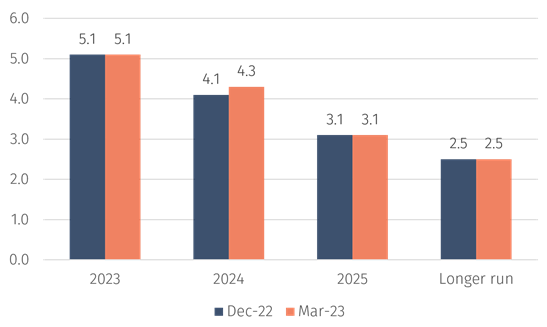Chair Powell stated that the US banking system is “sound and resilient” but acknowledged that credit conditions are likely to tighten as a consequence of recent events. That will lower inflation pressures, economic activity and employment, although the extent to which it will do so is highly uncertain. Nevertheless, the Fed does not expect that these tensions will have important macroeconomic effects.
The Federal Open Market Committee (FOMC) projections (see charts below) were almost entirely unchanged. The median FOMC member expects unemployment to fluctuate around 4.5% in 2023-25, but to fall to 4% in the longer run. PCE inflation is expected to be 3.3% in 2023, 2.5% in 2024, 2.1% in 2025, and 2% in the longer run. Real GDP growth is expected to be 0.4% in 2023, 1.2% in 2024, 1.9% in 2025, and 1.8% in the longer run.
Interest rate projections were remarkably unaffected by recent developments. The median FOMC member expects interest rates at the end of 2023 to reach 5.1%, that is, they expect one further 0.25% increase. The median projection for 2024 is 4.3%, for 2025 3.1% and in the longer run 2.5%.
Investment Insights • MFN
3 min read
The Fed raises interest rates by 0.25%
In a unanimous decision at its 22 March meeting and as expected, the Federal Reserve brushed aside concerns about the state of the US banking system and the risk of financial instability, raising interest rates by 0.25% to the range 4.75% - 5%. However, it changed its language in a dovish direction. While it previously said that “ongoing increases in the target range will be appropriate” it softened that to “some additional policy firming may be appropriate". Chair Powell emphasised in the press conference the words “some” and “may” and that this change in language was due to the high degree of uncertainty arising from recent banking tensions.
Chart 1. Unemployment rate (in %)

Chart 2. Real GDP growth (in %)

Chart 3. PCE inflation (in %)

Chart 4. Fed funds rate (in %)

Source: Federal Reserve Board. Data as of 22 March 2023.
Overall, the tone of the press conference was surprisingly upbeat – no doubt many commentators expected the Fed to view worries about the banking systems as likely to have a greater impact on the economy. Indeed, according to the CME Fed Watch Tool, immediately after the meeting financial markets were pricing two interest rate cuts during the year, presumably because they expect inflation pressures to abate and economic activity to slow more rapidly than the Fed.
In recent weeks fixed income markets have been exceptionally volatile, reflecting sharp shifts in market rate expectations about the outlook for monetary policy. Such shifts are normal at inflection points in the interest rate cycle, although even by historic standards the shifts in this cycle have been unusually large. Depending on the incoming macroeconomic data, further shifts in expectations are likely to occur over the coming weeks until the outlook for policy has become clearer.
